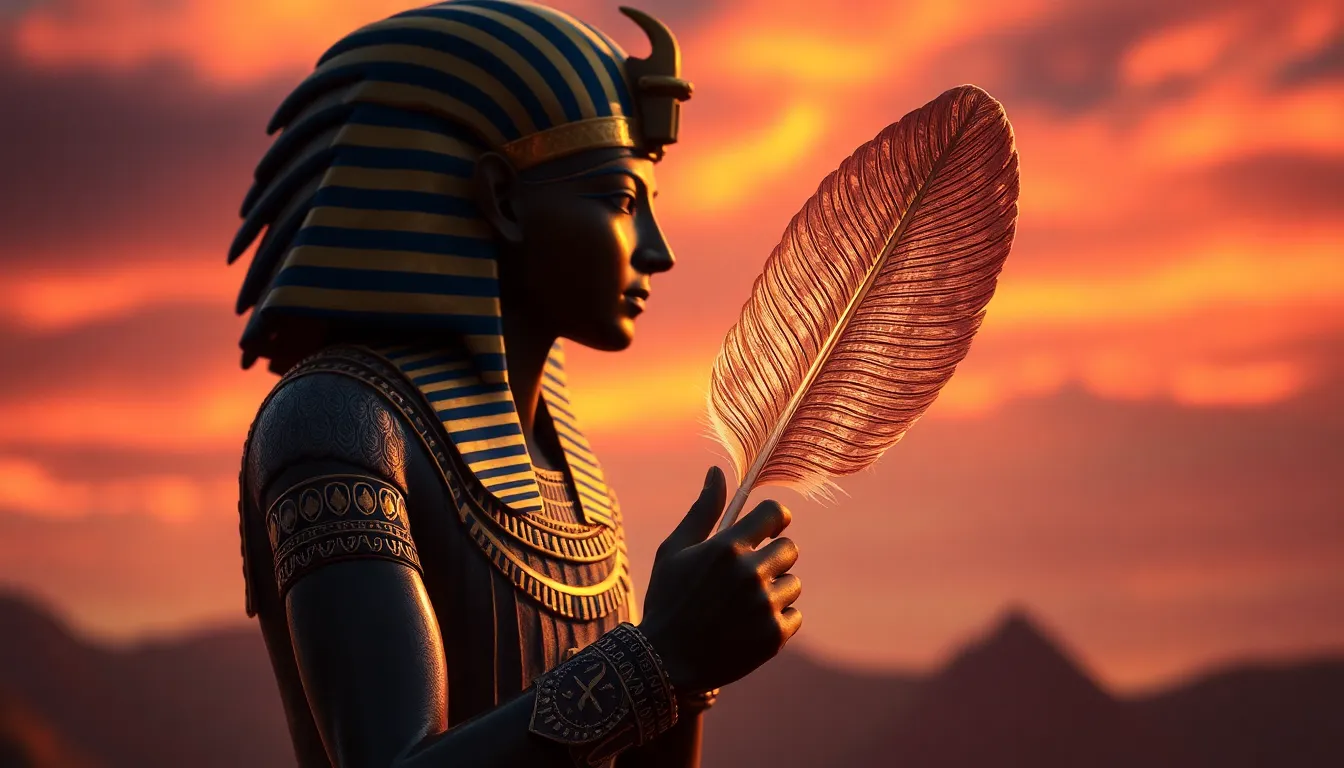The Role of the Feather of Ma’at in the Weighing of the Heart
I. Introduction
The Weighing of the Heart ceremony is a pivotal aspect of ancient Egyptian belief concerning the afterlife. It represents the moral judgment that every soul must face after death, determining their fate in the eternal realm. Central to this process is the Feather of Ma’at, which embodies truth and justice.
Ma’at, the goddess associated with these principles, holds a significant place in Egyptian mythology. Her representation as a woman with an ostrich feather on her head serves as a constant reminder of the balance and order that must be maintained in both life and the afterlife.
II. Understanding Ma’at: The Goddess of Truth and Justice
Ma’at is not merely a goddess; she represents a fundamental concept in ancient Egyptian culture. Her characteristics include:
- Truth
- Justice
- Harmony
- Order
In Egyptian society, the concept of Ma’at was vital for maintaining cosmic order and social harmony. To live according to Ma’at meant to live in truth and justice, influencing everything from governance to personal conduct. The pharaohs, as representatives of the gods on earth, were expected to uphold Ma’at to ensure the prosperity of their people and the favor of the gods.
III. The Symbolism of the Feather
The Feather of Ma’at is a powerful symbol within ancient Egyptian belief. Physically, it is depicted as a simple, elegant ostrich feather, representing lightness and purity. Its symbolism encompasses:
- Truth: It signifies the truthfulness of one’s actions and intentions.
- Balance: It represents the balance between chaos and order.
- Morality: The feather embodies the ethical standards that one must adhere to in life.
IV. The Weighing of the Heart Ceremony
The Weighing of the Heart ceremony is a critical ritual that determines the fate of the deceased in the afterlife. Conducted in the Hall of Two Truths, it serves to assess the worthiness of the soul before entering the eternal realm.
Key figures involved in this ceremony include:
- Anubis: The god of embalming and the guide of souls, who oversees the weighing process.
- Osiris: The god of the afterlife, who ultimately judges the soul’s fate based on the results of the ceremony.
V. The Process of Weighing the Heart Against the Feather
The process of weighing the heart against the Feather of Ma’at is a profound ritual. Here is a step-by-step explanation:
- The deceased is led into the Hall of Two Truths by Anubis.
- The heart, believed to be the seat of the soul, is removed from the body.
- It is placed on one side of a scale.
- The Feather of Ma’at is placed on the other side of the scale.
- As the scales balance, the heart’s weight is compared to the feather’s lightness.
The heart’s significance lies in its role as the embodiment of one’s moral character and ethical choices throughout life.
VI. Outcomes of the Weighing: Judgment and Consequences
The results of the Weighing of the Heart ceremony yield two possible outcomes:
- Passing the Test: If the heart is lighter than or equal to the feather, the soul is deemed worthy and granted access to the afterlife, where it can dwell in peace with the gods.
- Failing the Test: If the heart is heavier than the feather, it symbolizes a life filled with wrongdoings and injustice. In this case, the soul faces severe consequences, often depicted as being devoured by Ammit, the soul-eating monster.
This ritual underscores the importance of living a life aligned with the principles of Ma’at, as the consequences of failing the test are dire, leading to eternal unrest.
VII. The Feather of Ma’at in Cultural Context
The Feather of Ma’at has transcended ancient Egyptian culture, finding representation across various forms of art, literature, and religious texts. It appears in:
- Hieroglyphics and temple carvings that depict the weighing process.
- Religious texts such as the Book of the Dead, which describes the afterlife journey.
- Modern interpretations of justice, where Ma’at symbolizes fairness and ethical conduct.
The enduring influence of Ma’at continues to resonate in contemporary discussions surrounding justice and morality, serving as a timeless reminder of the importance of truth and balance in society.
VIII. Conclusion
The Feather of Ma’at holds a central role in the Weighing of the Heart, representing the fundamental principles of truth and justice that guide the fate of souls in the afterlife. This ancient belief system not only shaped the spiritual landscape of ancient Egypt but also offers valuable insights into contemporary discussions of ethics and morality.
As we reflect on these ancient beliefs, we recognize their relevance in our modern world, where the quest for justice and truth remains a perennial challenge.




